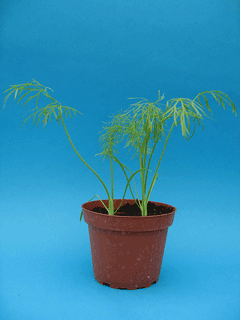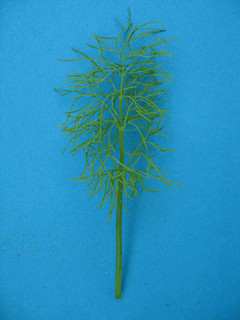 |
|
http://flickr.com/photos/25397586%40N00 |
 |
| http://flickr.com/photos/25397586%40N00 |
Translate this page:
Summary
Physical Characteristics

 Foeniculum vulgare azoricum is a PERENNIAL growing to 1.5 m (5ft).
Foeniculum vulgare azoricum is a PERENNIAL growing to 1.5 m (5ft).
See above for USDA hardiness. It is hardy to UK zone 7 and is not frost tender. It is in flower from August to October, and the seeds ripen from September to October. The species is hermaphrodite (has both male and female organs) and is pollinated by Insects. The plant is self-fertile.
Suitable for: light (sandy), medium (loamy) and heavy (clay) soils and prefers well-drained soil. Suitable pH: mildly acid, neutral and basic (mildly alkaline) soils. It cannot grow in the shade. It prefers dry or moist soil. The plant can tolerates strong winds but not maritime exposure.
UK Hardiness Map
US Hardiness Map
Synonyms
F. azoricum.
Plant Habitats
Cultivated Beds;
Edible Uses
Edible Parts: Leaves Root Seed Stem
Edible Uses: Condiment
Leaves - raw or cooked[52]. A delicious aniseed flavour, the young leaves are best since older ones become tough. They make a very nice addition to mixed salads[K]. Leaf stalks and stem base - raw, cooked or used as a flavouring in soups etc[50, 61, 183]. A strong, aniseed flavour[K]. They are often blanched before being eaten[183]. Very low in carbohydrates, proteins and fats[132]. Seeds raw or cooked. They have a delicious aniseed flavour and are used as a flavouring in cakes, bread etc[52, 183]. Root - cooked[53]. The flavour is somewhat parsnip-like[K]. A herb tea can be made from the seeds or the leaves[16, 183].
References More on Edible Uses
Medicinal Uses
Plants For A Future can not take any responsibility for any adverse effects from the use of plants. Always seek advice from a professional before using a plant medicinally.
Analgesic Antiinflammatory Antispasmodic Aromatic Carminative Diuretic Emmenagogue Expectorant
Galactogogue Hallucinogenic Stimulant Stomachic Urinary
Fennel is a commonly used household remedy, being useful in the treatment of a variety of complaints, especially those of the digestive system. The seeds, leaves and roots can be used, but the seeds are most active medicinally and are the part normally used[4]. An essential oil is often extracted from the seed for medicinal use, though it should not be given to pregnant women[4, 238]. The plant is analgesic, anti-inflammatory, antispasmodic, aromatic, carminative, diuretic, emmenagogue, expectorant, galactogogue, hallucinogenic, laxative, stimulant and stomachic[4, 7, 9, 21, 147, 165, 176, 192, 238]. Fennel is often added to purgatives in order to allay their tendency to cause gripe, and also to improve the flavour[4]. An infusion of the root is used to treat urinary disorders[238]. An essential oil obtained from the seed is used in aromatherapy. Its keyword is 'Normalising'[210]. The essential oil is bactericidal, carminative and stimulant[218]. Some caution is advised, see notes above on toxicity[222].
References More on Medicinal Uses
The Bookshop: Edible Plant Books
Our Latest books on Perennial Plants For Food Forests and Permaculture Gardens in paperback or digital formats.

Edible Tropical Plants
Food Forest Plants for Hotter Conditions: 250+ Plants For Tropical Food Forests & Permaculture Gardens.
More

Edible Temperate Plants
Plants for Your Food Forest: 500 Plants for Temperate Food Forests & Permaculture Gardens.
More

More Books
PFAF have eight books available in paperback and digital formats. Browse the shop for more information.
Shop Now
Other Uses
Dye Essential Repellent Strewing
The seed yields up to 5% of an essential oil[1, 4, 46]. This is used medicinally, as a food flavouring, in toothpastes, soaps, perfumery, air fresheners etc[1, 46, 238]. The flavour of fennel oil depends upon its two main constituents. 'Fenchone' is a bitter tasting element whilst 'anethole' has a sweet anise-like flavour[238]. The proportions of these two ingredients varies according to strain and region. Plants growing in the Mediterranean and southern Europe usually have a sweet oil whilst plants growing in central and northern Europe usually produce a more bitter oil[238]. The quality of the oil also depends upon how well the seed has been dried - the oil from fully ripened and dried seeds being much sweeter and more fragrant[245]. The dried plant is an insect repellent[14, 53], the crushed leaves are effective for keeping dogs free of fleas[201]. The plant was formerly used as a strewing herb[201]. Yellow and brown dyes are obtained from the flowers and leaves combined[168].
Special Uses
Dynamic accumulator Scented Plants
References More on Other Uses
Cultivation details
Succeeds in most soils[1] but prefers a sunny dry position[200]. A cultivated form of F. vulgare, grown for its edible swollen leaf bases, there are some named varieties[183]. This is the genuine Florence fennel[200]. Attracts bees and hoverflies[24]. Fennel is a poor companion plant in the garden, it inhibits the growth of nearby plants, especially beans, tomatoes and kohl rabi[14, 18]. It is itself inhibited by wormwood and coriander[14, 18].
References Carbon Farming Information and Carbon Sequestration Information
Temperature Converter
Type a value in the Celsius field to convert the value to Fahrenheit:
Fahrenheit:
The PFAF Bookshop
Plants For A Future have a number of books available in paperback and digital form. Book titles include Edible Plants, Edible Perennials, Edible Trees,Edible Shrubs, Woodland Gardening, and Temperate Food Forest Plants. Our new book is Food Forest Plants For Hotter Conditions (Tropical and Sub-Tropical).
Shop Now
Plant Propagation
Seed - best sown in early spring in situ[1]. Division in March as the new growth appears[16, 200].
Other Names
If available other names are mentioned here
Native Range
Coming Soon
Weed Potential
Right plant wrong place. We are currently updating this section.
Please note that a plant may be invasive in one area but may not in your area so it's worth checking.
Conservation Status
IUCN Red List of Threatened Plants Status :

Growth: S = slow M = medium F = fast. Soil: L = light (sandy) M = medium H = heavy (clay). pH: A = acid N = neutral B = basic (alkaline). Shade: F = full shade S = semi-shade N = no shade. Moisture: D = dry M = Moist We = wet Wa = water.
Now available:
Food Forest Plants for Mediterranean Conditions
350+ Perennial Plants For Mediterranean and Drier Food Forests and Permaculture Gardens.
[Paperback and eBook]
This is the third in Plants For A Future's series of plant guides for food forests tailored to
specific climate zones. Following volumes on temperate and tropical ecosystems, this book focuses
on species suited to Mediterranean conditions—regions with hot, dry summers and cool, wet winters,
often facing the added challenge of climate change.
Read More
Expert comment
Author
(Mill.)Thell.
Botanical References
200
Links / References
For a list of references used on this page please go here
Readers comment